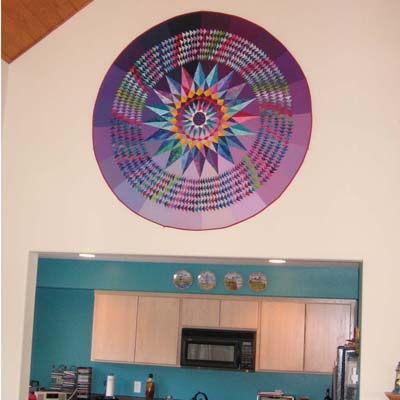
Since I just started this blog a few days ago, I feel I have to go back to the beginning to explain what my experiences have been with quilting and to show how I got to where I am today, the owner of a growing custom quilt business. My first two blogs show off the last two quilts I’ve made – two wonderful tie quilts. The third blog explores my first big challenge as a quilter – an appliqued quilt, the Rain Forest Quilt.
The quilt above was an even greater challenge. Finishing this quilt definitely gave me the confidence as a professional quilter. This quilt was the result of a commission from Paul and Sue DuPont, my boss at the time and his wife. They had seen the Rain Forest Quilt and wanted me to make a quilt for them. They wanted a quilt about 4’x6′ to hang over the entrance to their kitchen in their new beach house. The only request was that I somehow use the aqua color on the walls of their kitchen in the quilt. See below for the resulting wall hanging:

I had originally planned a rectangular quilt, but the dimensions of this pattern were too large for the site, so I ended up making my first (and only) round quilt. This presented some challenges to my boss, Paul DuPont, but being a mechanical engineer, he fashioned a circular metal pipe or bar to correctly hold the quilt in place.

In the picture above, Sue displays the quilt while standing on the deck of her beach house. The beach house faces the ocean and surrounding forests from a perch high above the town of Manzanita, so the quilt is facing out towards the beach where wall to wall windows surround the living room.

I made my own pattern after seeing a similar picture in Judy Mathieson’s book “Mariners Compass”. I thought both the Mariners Compass and the flying geese were good beach themes. In her book, Judy explains her unique paper piecing technique, which I followed. It was the only way to make these flying geese with any precision. The “geese” get slightly larger from inside the circle to outside so there was no use my trying to piece them without a paper backing. Judy’s method uses wax paper that is folded back at the seams so that the paper is not sewn on. As a result there is no paper to remove and no seams to stretch. Anyone who has used the older methods can greatly appreciate Judy’s method.
Using her instructions, I made only eight templates for the geese, because the templates can be pulled off after the seams are sewn and used again and again.

The only difficult part in making this quilt was putting in those red diamonds shown above. Even Judy’s paper piecing has its limits – which were met at that point. I had to sew those diamonds in by hand.
Incidentally, I could not manage to draw the design for this quilt, although I gave it a valiant try. Finally I had my friend and CAD drafter Neal Keller draft it for me.

Below is a picture of the quilt on the design wall of my Salmon Creek studio before it was quilted and before I was certain what size I wanted it to be. I had so much fun making this quilt, that someday I want to do it again using different colors.

